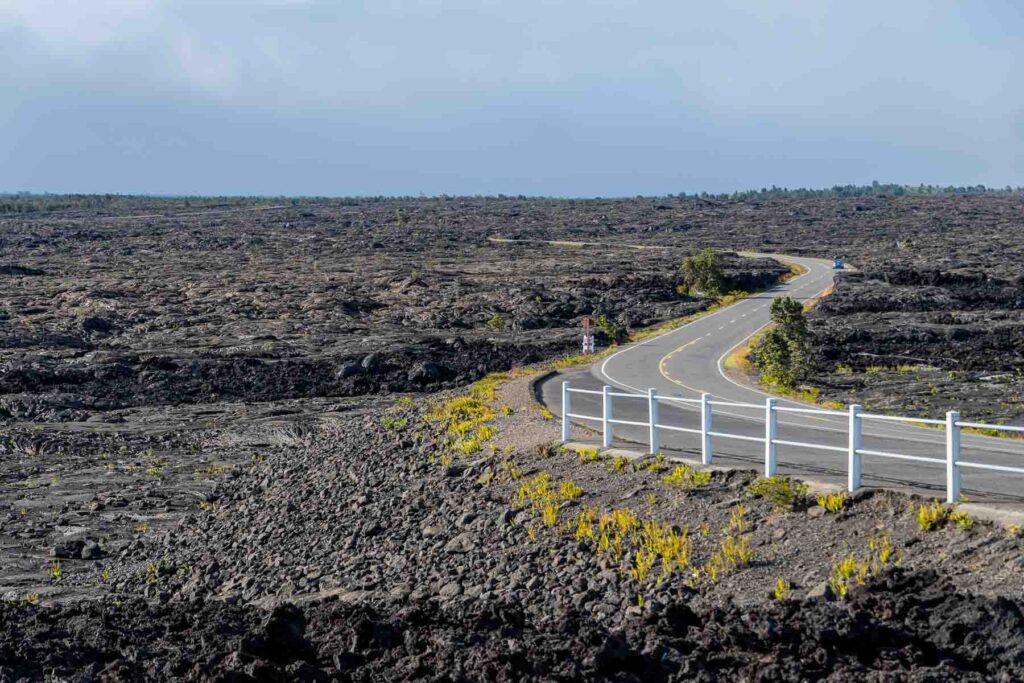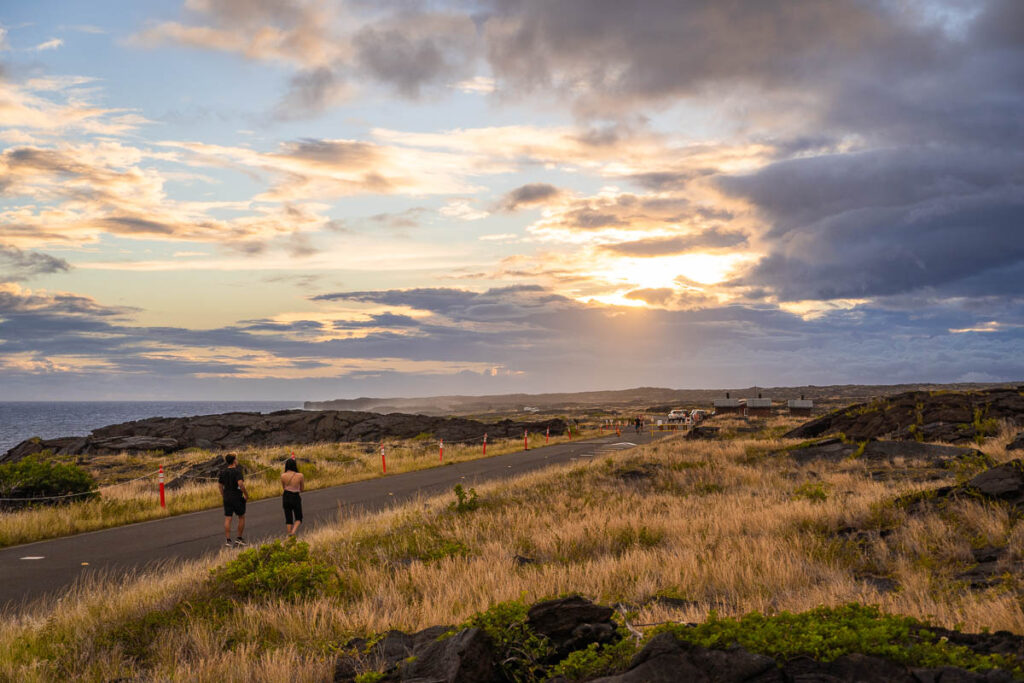Best Time To Visit Volcanoes National Park (And The Worst!)

When is the best time to see the home to two of the world’s most active volcanoes and where you can see lava flowing into the ocean?
During my one-month trip to Hawaii, I arrived at this Big Island for a two week stay in December. The weather in Hawaii is great at all times of the year, and this stint was no different. Save for some rainy days, but that’s normal in the rainy season.
Unlike many other US National Parks, Volcano National Park is pretty consistent with the weather and visitor numbers year-round, as it is both tropical and touristy. But these are the seasons at Hawaii Volcanoes.
- Peak Season: June to September
- Dry Season: April to October
- Rainy Season: November to March
Coming up, I’ll share details about Hawaii seasons, must-see events, and monthly climate breakdowns. Whether you’re going for one day to the volcanoes or staying longer, hiking the crater rim trail, or exploring the Thurston Lava Tube, these are the best times to go to Hawaii Volcanoes National Park.

Best Time to Visit Volcano National Park
Best Time of Year to Visit
In general, the best time to visit Hawaii Volcanoes National Park is in the dry season. And if you want to avoid peak crowds, come in May or September.
The weather is typically sunny and dry, so you can hike the Kilauea Iki trail or explore the steam vents without getting caught in a downpour. There’s a higher chance of clear skies for views of the lava glow at night if the volcano is erupting or going up to Mauna Loa for stargazing.
Travel Tip! As of 2024, there are no eruptions, so no glow or lava.
Best Time for Good Weather
Being so close to the equator, Hawaii is known for its sunny and warm weather year-round. So, the best time to visit if you want to avoid rain is during the dry season of April to October. The temperatures range from 70-80°F (21-27°C) with less chance of rain.
With that said, don’t let the rain deter you; it usually comes fast but goes fast too.
Best Time for Smaller Crowds
The visitor numbers in Hawaii Volcanoes National Park are shockingly consistent month to month. And for a park of its size and level of accessibility, as in not that massive, it receives over 1.5 million visitors a year.
The obvious answer would be to steer clear of summer and the winter holidays since schools are out and most families are on vacation.
Rather than telling you the best season to visit for fewer crowds, I’d suggest coming before 10 am or closer to sunset. Around mid-day, many parking spots, especially near the Thurston Lava Tube, tend to get packed.
Cheapest Time to Visit
Based on my research, if you’re looking to save some cash on your trip to Hawaii, there are a few times throughout the year when flights and accommodations are more affordable.
The cheapest time to fly to Hawaii is typically during February and March. These months fall outside the high-demand holiday season and before the summer rush.
If you’re flexible with your dates, plan for April (after Easter) or May. These spring months often see a drop in tourism, which can lead to lower prices. The same goes for September through early December, just before the holiday season kicks off.
Best Time for Stargazing
Although the park is not officially recognized as a Dark Sky Park by the International Dark-Sky Association, it does have some incredible stargazing up on the summit of Mauna Loa. Bring a jacket; it gets cold up there.
For the clearest starry skies, the best time for stargazing is the dryest months between May and September. This period has the least cloud cover.

Worst Time to Visit
Avoid visiting Hawaii Volcanoes National Park during the rainiest months, usually from November to March. It’s when the park gets lots of rain, making hiking conditions less fun and views less impressive.
However, the rains usually pass quickly. You just might need to sit in the car for an hour.
Park Closures
The park is usually open 24/7, every day of the year! But as you know from the name, there are a lot of volcanos. So, there are volcanic eruption risks and unforeseen closures due to it.
Kilauea volcano isn’t currently erupting, but attractions like the Jagger Museum remain closed indefinitely after being damaged during the 2018 eruption. Similarly, parts of the Crater Rim Drive are closed for hazardous conditions created by the volcanic activity.

Seasons at Volcano National Park
Rainy Season (November to March)
The rainy season in Hawaii Volcanoes National Park runs from November through March, during which the park experiences frequent rainfall. This is nature’s way of nourishing the lush, tropical landscapes of the Big Island. Pack a waterproof jacket, sturdy rain boots, and perhaps a change of clothes.
But with the rain comes the thriving flora in vibrant shades of green. Waterfalls that may be trickling during the dry season transform into roaring cascades. On the flip side, the trails can get slippery, and the views are less clear due to cloud cover.
While continuous heavy downpours are rare, there can be brief but intense showers. The rain usually doesn’t last all day, and you may even enjoy a beautiful rainbow arching over the volcanic craters.
Dry Season (April to October)
The dry season runs from April to October. It is a time of relative sunshine and clear skies. The trails are easier to navigate, and the volcanic landscapes are less unhindered by cloud cover or mist. But this isn’t to say it never rains; it definitely still does being a tropical destination and all.
The lower humidity levels during these months make hikes more comfortable, and the temperature is just right.
This sunny season also has the best conditions for viewing the park’s most notorious attraction – the volcanoes. With clear skies, you can see the nighttime glow of the lava flows should the volcanoes be active. Even during dormant periods, a nighttime visit is worth it for the stars.
Coupled with the rain and the school vacations, the dry season is a popular time for tourists, so expect slightly larger crowds at popular spots. To avoid the masses, start your day early!

Volcano Weather By Month
Here is a month-by-month breakdown of the average high and low temperatures and precipitation at Volcano National Park:
Sure, here’s the information in a simple, easy-to-understand format. I’ve created a table with the average low and high temperatures for each month, as well as the monthly precipitation values:
| Month | Average Low Temp | Average High Temp | Precipitation (inches) |
|---|---|---|---|
| Jan | 63.6°F | 79.2°F | 5.28 |
| Feb | 63.5°F | 79.4°F | 5.49 |
| Mar | 64.7°F | 79.2°F | 7.42 |
| Apr | 65.6°F | 79.3°F | 5.15 |
| May | 66.7°F | 80.6°F | 3.97 |
| Jun | 68.0°F | 82.2°F | 3.14 |
| Jul | 69.2°F | 82.5°F | 3.87 |
| Aug | 69.4°F | 83.2°F | 3.99 |
| Sept | 69.0°F | 83.4°F | 3.71 |
| Oct | 68.5°F | 82.7°F | 4.66 |
| Nov | 67.2°F | 80.7°F | 6.12 |
| Dec | 64.9°F | 79.5°F | 6.23 |
Best Time of Day to Visit
If the volcano is erupting, then nighttime would be awesome! Otherwise, sunset is undoubtedly a magical time of day to visit the Hawaii Volcanoes National Park. I highly recommend going to the Holei Arch for sunset (pictured below) and seeing the sun dip below the horizon as it casts orange across the lava fields and rocky coast.
Time of Day to Visit:
- Morning (6 am – 10 am): The park is relatively quiet and the temperatures are cooler. Parking spaces are also more widely available, especially near the popular Thurston Lava Tube.
- Midday (10 am – 2 pm): The park can get rather busy, especially during peak seasons. It’s also the hottest part of the day, so stay hydrated.
- Afternoon (2 pm – Sunset): The crowds start to thin out; as mentioned, you can’t miss the sunset colors.
- Night (Post-sunset): The park’s beauty doesn’t vanish with the sun. If the volcanoes are active, you can see the lava’s glow, and on clear nights, the stargazing is exceptional.

Special Events or Festivals
The Big Island is not large, so if any cool events are happening realistically, you can drive to any of them anywhere. But here are a few special ones near Volcano National Park.
- Experience Volcano Festival – Ready for music, Hawaiian culture, art, and more? This festival is set for the weekend of July, from kids’ activities to happy hours and food tours.
- Merrie Monarch Festival – Although it’s not directly in the park, this annual event in Hilo is the world’s largest hula competition. It usually happens after Easter Sunday in March-April.
- Events at Park Facilities – The Volcano Art Center Gallery, Volcano House, and Kilauea Military Camp have various events throughout the year.
- Hawaiian Cultural Festival – This annual event at the park celebrates Hawaiian culture with music and traditional practices.
Before you Close That Tab…Where to Next in Hawaii?
Hawaii may have been the site of a family vacation when I was twelve, but having gone back for a month as an adult is even better. If you’re looking for other places in Hawaii too, check out these other posts I have on the archipelago.
- Perfect One Day In Volcano National Park Itinerary
- Perfect Day Trip to Big Island Itinerary: Hawaii Guide
- Epic Day Trip to Maui Itinerary for the Adventurous
Catherine, a seasoned travel writer, has lived in 4 different states and explored 36 states and 28 national parks. After spending two years embracing van life, she's now dedicated to sharing her vast knowledge of day trips across America. Catherine's other works has been referenced in major publications like MSN, Self, and TripSavvy.
| MY FAVORITE TRAVEL RESOURCES |
✈️ Find amazing guided tours and experiences with Viator to maximize your time! 🏘️ Plan ahead and secure your accommodation with Booking.com in advance. 🧾 Rent a car with Discovercars in advance and get the best prices for your day trip adventures. |

